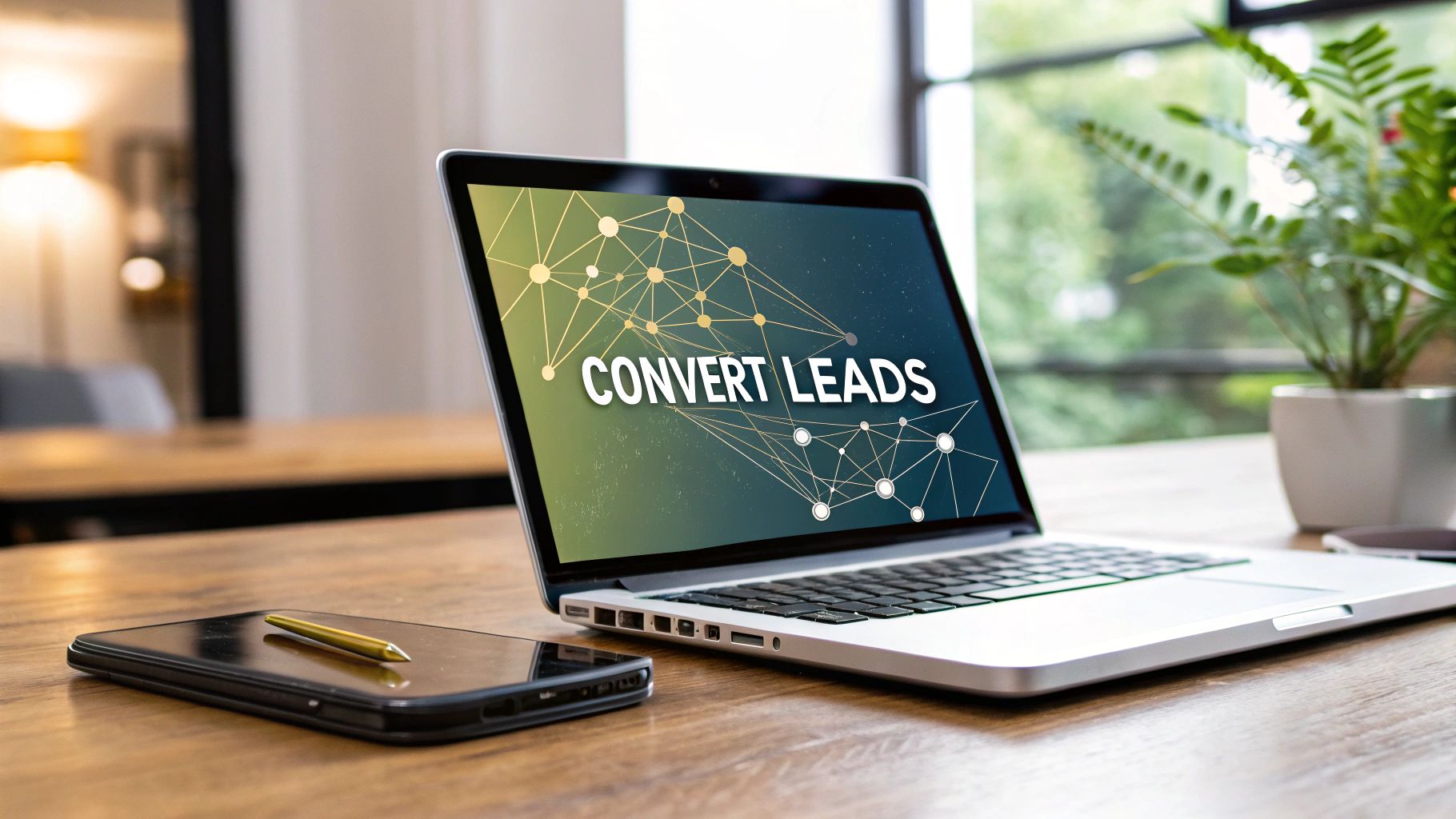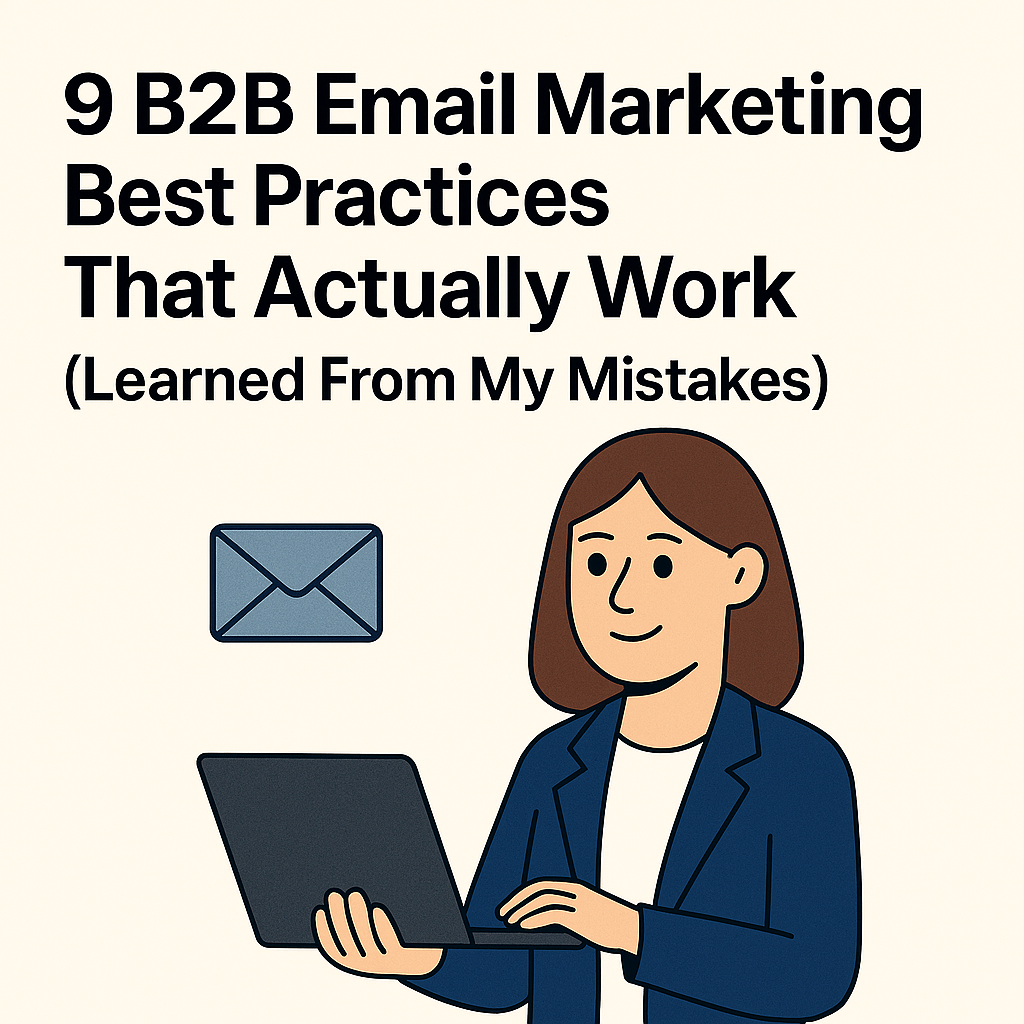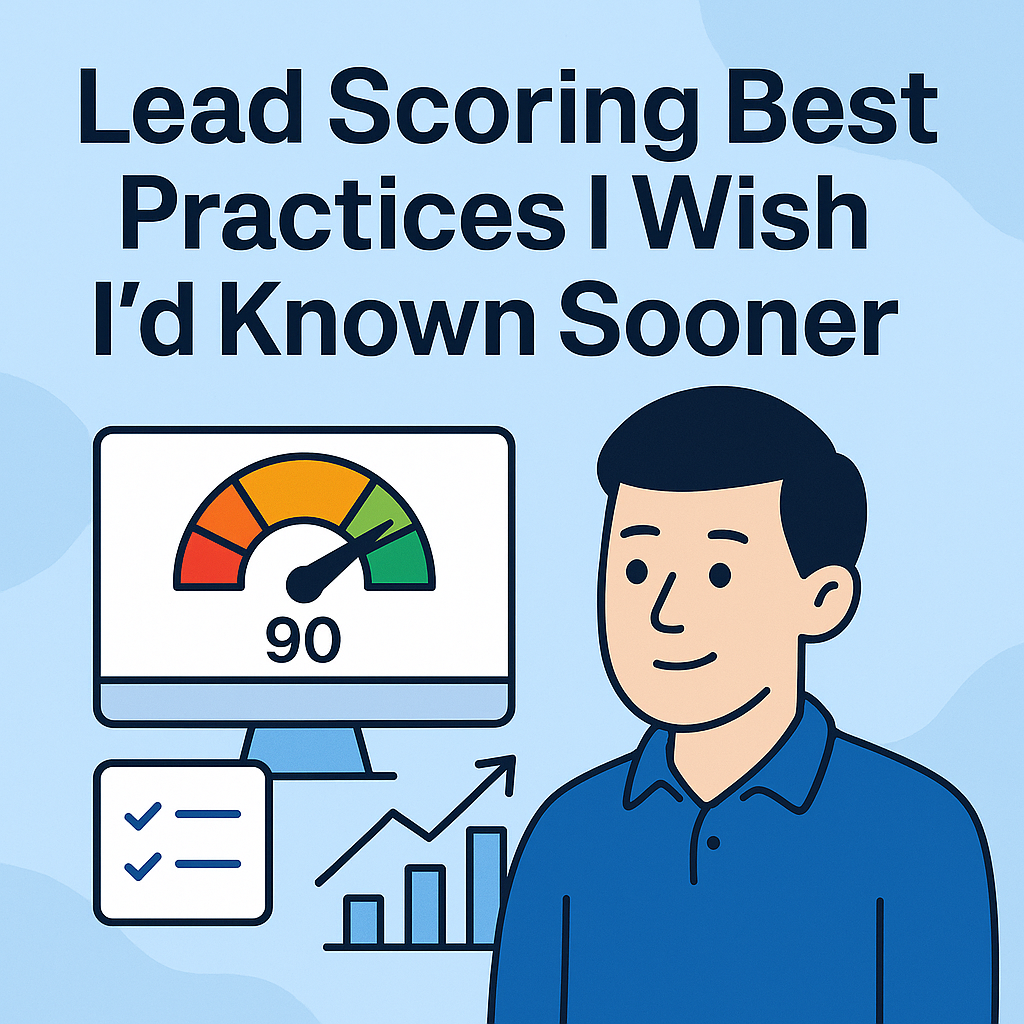How to Find Sales Leads: My Playbook for Ditching Cold Calls & Finding Buyers Ready to Talk

Finding quality sales leads isn't about casting the widest Net. It's about being incredibly specific about who your ideal customer is and then spotting the buying signals they give off. Often, before they even realize they’re in the market. This is the secret to shifting from cold, interruptive outreach to having warm, relevant conversations that close.
Ditch the Old Playbook to Find Sales Leads That Matter

Let's be honest, most guides on finding sales leads rehash the same old advice. You've heard it all before: "know your audience," "use social media." This isn't one of those guides.
I want to share what I've learned from my own mistakes, and believe me, I've made plenty. I once spent an entire month chasing what I thought was a "hot" lead at a huge company. It turned out he was a brand-new intern with absolutely no purchasing power. Classic mistake; I was chasing a fancy title, not a real opportunity. We're going to make sure you don't fall into that same trap.
The whole process starts by abandoning the shotgun approach. Instead, we're going to get ruthless about defining your Ideal Customer Profile (ICP).
An empty pipeline is scary, but a pipeline full of unqualified leads is a trap. It gives you the illusion of progress while draining your time, resources, and morale. The goal is a full pipeline, not just a busy one.
Start With Who, Not How
Before selecting your outreach strategy, find out who you're speaking to. Who is your perfect customer? What specific problem keeps them up at night? Where do they go online to find answers or complain about those problems?
Drill down on the specifics:
- Job Titles & Departments: Who feels the pain your solution solves most acutely? Is it a VP of Marketing or a frontline sales manager?
- Company Size & Industry: What kind of companies see the biggest ROI from your product? A 50-person tech startup has very different needs than a 5,000-person manufacturing firm.
- Tech Stack: What tools are they already using? This can be a goldmine of information, signaling compatibility or a gap your product can fill.
This isn't just a fluffy marketing exercise; it's the bedrock of your entire sales strategy. Knowing these details helps you spot opportunities everyone misses. Consider this: lead generation is a top priority for 50% of marketers. With the average cost per lead climbing to nearly $200, you can't afford to be imprecise. Nailing your ICP means your budget is channeled toward people who are capable of patronizing you.
Qualified vs. Unqualified Leads
Here’s the simple distinction that will save you countless hours: a "lead" is just a contact. A "qualified lead" is someone who fits your ICP and is showing signs that they’re getting ready to make a purchase.
Learning to spot these buying signals is your new superpower. These are the subtle clues that indicate someone is moving from idle curiosity to actively finding a solution. A great place to start is by learning the 13 intent signals to get high-intent leads without cold outreach. This is how you stop chasing prospects and start attracting real buyers.
Turn Your Website Into a 24/7 Lead Generation Machine
Is your website just a fancy digital brochure? For years, my first company website was exactly that: an online billboard that returned almost zero business. It was an expensive lesson. I learned the hard way that a passive site is a useless site.
Your website should be your hardest-working sales rep, clocking in 24/7. Let's see how to transform it from a static page into an active engine for finding and capturing quality sales leads. This isn't about flashy tricks; it's about creating a genuinely helpful experience that guides visitors toward giving you their information because they see clear value in it.
Build Landing Pages That Convert
A landing page has one goal: get a visitor to take a single, specific action. That's it. Forget cramming every feature you have onto the page. You need a powerful headline, crystal-clear benefits (not just features), and social proof such as testimonials or case studies to build trust.
- One Page, One Goal: A landing page should focus on a single offer, such as a demo request or ebook download. Bombarding visitors with multiple calls-to-action (CTAs) creates confusion and tanks your conversion rates.
- Make Your CTA Irresistible: Ditch boring words like "Submit." Use action-oriented text that screams value, words like "Get My Free Checklist" or "Show Me How It Works." Make it compelling!
- Never Ask for Their Life Story: In my early days, my forms asked for everything but a blood type, and this is a huge mistake. Start with just an email address. You can always gather more info later on. A long, intimidating form is a conversion killer.
The data backs this up. Websites are the absolute foundation for lead generation. A staggering 90.7% of marketers are banking on their websites to capture leads and drive sales in 2025. This is often supported by content marketing and social media, with 67.8% of marketers funneling that precious lead data directly into a CRM. If you're interested, you can explore more lead generation stats to see the full picture.
This is why mapping out your channels is so important. Each one plays a vital role in attracting potential leads and guiding them back to your central hub, your website.
Choosing the Right Sales Lead Channels for Your Strategy
Not all lead generation channels are created equal. Where you spend your time and money depends entirely on your audience and your goals. A solid strategy involves a mix of channels, each playing to its strengths.
Below is a quick breakdown to help you prioritize your efforts.
Lead Generation Channel Effectiveness
This table isn't about picking just one channel; it's about understanding how they work together. Your blog builds the authority that fuels your SEO, while your paid ads can drive immediate traffic to a high-converting landing page.
Your Simple But Powerful Tech Stack
You don't need a dozen complicated and expensive tools to get started. Over-complicating your tech stack is one of the fastest ways to get bogged down.
My Personal Rule: If a tool takes more than a day to set up and understand, it's too complex for a lean team. Simplicity scales. Complexity creates bottlenecks.
Here’s the essential stack you need to capture and organize your sales leads effectively:
- A Reliable CRM: This is your command center. It's where every lead lives. A good CRM like GojiberryAI helps you track interactions, schedule follow-ups, and view your entire pipeline at a glance.
- Simple Analytics: You have to know what's working. Where are people coming from? Which pages do they visit before they are converted? This data is pure gold for making smarter decisions.
- A Smart Chatbot: I'm not referring to a clunky robot from the '90s. Modern chatbots can qualify leads, book meetings, and answer common questions around the clock, freeing you up for high-value conversations.
Keeping this simple system in place means you’ll be ready to capture and qualify leads the moment they show interest. It’s the foundation for building a predictable, scalable process for growth.
Mastering the Follow-Up to Close More Deals

Alright, a new lead just landed in your CRM. High-five! So... what happens next? This is where most sales efforts either succeed brilliantly or fail spectacularly.
The biggest mistake I see? Salespeople swing between two extremes: being aggressive ("just checking in" email every single day) or painfully passive (waiting for the lead to come back to them). I've been guilty of both. Early in my career, I once sent five follow-ups in a week to a promising lead, only to get a blunt "Please stop emailing me" in response. Ouch.
The truth is, most leads aren't ready to buy the second they download your ebook. The real magic lies in the follow-up.
The Myth of the First Touch Conversion
Let’s get one thing straight: you will rarely close a deal on the first touchpoint. Thinking you will is like proposing on a first date; it’s just too soon. The goal of the follow-up isn't to pester; it's to build trust and stay top-of-mind by providing value.
Modern buyers are savvy. They conduct their research and move at their own pace. This is why a multi-touch sequence is non-negotiable. Forget generic outreach. We’re talking about smart, strategic engagement that turns a curious prospect into a warm lead who’s excited to get on a call with you.
What to NEVER do: Send a follow-up email with the subject line "Following Up" or "Checking In." It adds zero value and immediately signals that you have nothing useful to say. It’s the sales equivalent of a dead-end street.
The number of touchpoints needed can vary wildly. While some inactive customers might convert after just a few interactions, warm inbound leads often require between 5 and 12 touchpoints. For cold prospects, it could take as many as 20 to 50 meaningful engagements before they become customers.
Building Your Value-Packed Follow-Up Sequence
So, how do you stay persistent without being annoying? You create a sequence that gives, gives, and gives before you ask. Your mission is to position yourself as a trusted advisor, not just another vendor trying to hit a quota.
Here’s a sample flow you can adapt:
- Touch 1 (Day 1 - Email): Thank them for their interest (e.g., downloading your guide). Offer another piece of high-value content, like a related case study or a short video explaining a key concept.
- Touch 2 (Day 3 - Social Media): Connect with them on LinkedIn. Don't send a salesy message. A simple, "Hi [Name], saw you were interested in [Topic]. I share a lot of content on that here and thought it would be valuable to connect," works wonders.
- Touch 3 (Day 5 - Email): Send a personalized video message using a tool like Loom. Briefly introduce yourself and reference a specific point about their company or industry. This shows you've done your homework and helps you stand out in a crowded inbox.
- Touch 4 (Day 8 - Email): Share a helpful third-party article or a recent industry trend that's relevant to their role. Frame it as, "Thought you'd find this interesting."
- Touch 5 (Day 12 - The Ask): Now that you've built rapport and provided value, you've earned the right to ask for a meeting. Be direct but not pushy.
This isn't just about emails and calls. Tracking these interactions is crucial. You can learn how to master the sales follow-up call using AI meeting recordings to analyze what's working and refine your approach. This combination of strategic outreach and smart analysis is how you build a system that closes deals.
Let AI Find Your Sales Leads While You Sleep
Ready for what feels like an unfair advantage? Let’s talk about using AI for prospecting.
I’ll be honest, I was a skeptic at first. I pictured overly complex dashboards with a price tag only a massive corporation could justify. My first dive into AI for sales was a disaster; I used a clunky tool that spat out a messy spreadsheet of questionable contacts. It felt like a huge step backward.
But things have changed a lot. Today's AI platforms are all about precision, automation, and giving you back your most valuable asset: time. Imagine an assistant working for you 24/7, scanning millions of data points to find companies that are a perfect match for your ideal customer profile. This isn't science fiction anymore.
This is how you scale your outreach without getting yourself in busywork. It’s about letting your sales team focus on what they do best, building relationships and closing deals.
A Practical AI Prospecting Walkthrough
Let's get practical. It’s a lot simpler than you might think. Our goal is to create a campaign that automatically finds qualified leads and feeds them directly to you.
Here’s a look at how this works with a tool like GojiberryAI:
Step 1: Set Up Your Search Criteria
First, you need to teach the AI exactly who to look for. This goes so much deeper than just industry or company size. Think about the real-world signals that indicate a company needs you.
For example, you can get incredibly specific with triggers like:
- Companies that just hired a new VP of Sales
- Startups that recently announced Series A funding
- Businesses that are actively hiring for remote engineering roles
These are powerful buying signals that are almost impossible to track manually at scale.
Step 2: Pinpoint the Right People
Next, instruct the AI on which job titles to target inside those companies. Are you selling to the CTO, the Director of Marketing, or the Head of People? Be specific. The AI will then dig in and find you the exact decision-makers you need to talk to.
Step 3: Launch and Let the AI Do the Work
Once your criteria are locked in, you launch the campaign. From there, the AI gets to work, monitoring signals across platforms like LinkedIn in real time. When it finds a company and a person that match your rules, it enriches their contact information (with verified emails) and delivers it right to your dashboard.
A Word of Caution: Never set your criteria too broadly. A campaign looking for "any tech company in the US" is a recipe for a low-quality list. A campaign searching for "SaaS companies with 50-200 employees that are currently hiring software engineers" is a goldmine. Precision is everything.
You aren't just getting a random list. You're getting a curated, live feed of warm leads who are practically raising their hands to say they need a solution like yours right now.
Turning an AI Signal into a Sales Conversation
So, what does this look like? Let's say your ideal customer is a fast-growing B2B software company.
- The AI Alert: You get a notification from GojiberryAI. A 100-person SaaS company just posted three new job openings for "Account Executives."
- Your Action: This is a massive buying signal! They're scaling their sales team, which means they're almost certainly feeling the growing pains that come with it; pains your product can solve.
- The Outreach: The AI has already found the Head of Sales for you. Now you can craft a hyper-relevant message: "Saw you're expanding the sales team at [Company Name]. As you scale, managing the pipeline effectively becomes crucial. Our platform helps leaders like you solve for X."
This completely flips the script on traditional outreach. You transform from being a cold interruption to a timely, helpful resource. You're showing up at the exact moment they're feeling the pain you solve. This is how you stop chasing leads and start having conversations that lead somewhere.
Ready to put your prospecting on autopilot? A tool like GojiberryAI can start uncovering these high-intent leads for you today.
Time to Take Action and Build Your Pipeline
We've covered a lot of ground, from defining your ideal customer to using AI to find them. But knowledge without action is just trivia. The real magic happens when you build a repeatable system that brings in high-quality leads. This isn't just about finding more leads; it's about finding the right leads and having smarter conversations that lead to closed deals.
You now have a playbook that goes beyond the generic advice. You have concrete steps, real-world mistakes to avoid, and the exact strategies I've used to build successful sales engines. The difference between a struggling sales team and a high-performing one often comes down to one thing: a disciplined, intelligent process.
So, what's your first step? Will you refine your ICP, build a value-packed follow-up sequence, or explore how AI can automate your prospecting? The choice is yours, but the key is to start now. The health of your pipeline next quarter depends on the actions you take this week. You've got this.
FAQ: Your Top Sales Lead Questions Answered
H3: How do I know if a lead is qualified?
Beyond basic fit (company size, industry), the truest sign of a qualified lead is Pain. Do they have an urgent problem that is costing them time, money, or peace of mind? A company that fits your ICP but has no recognized pain is just a "good fit on paper." A company with an urgent problem it needs to solve is a real opportunity. Your job in discovery is to find and quantify that pain.
H3: What's the biggest mistake people make when looking for leads?
Thinking that prospecting is just about finding contact information. That’s the easy part. The real mistake is launching into a generic pitch without understanding context. Why should this person care about what you have to say today? Without a compelling reason or trigger event, you're just another unread email. Always lead with relevance, not with your resume.
H3: I'm a one-person team. How can I possibly do all of this?
Focus on the 80/20 rule. Don't try to be everywhere. What to do: Pick one or two channels where your ideal customers live (like LinkedIn groups or a specific online community) and dominate them. Become a helpful, known voice there. What to NEVER do: Spread yourself thin across five different social platforms with low-quality posts. And lean on automation. A simple AI tool for prospecting and a good CRM to keep you organized aren't luxuries; they're force multipliers that will save your sanity.
Tired of the guesswork? What if you could get a daily stream of warm, high-intent leads delivered right to you? GojiberryAI pinpoints companies actively revealing buying signals on LinkedIn and provides enriched contact details. It's time to stop the manual grind and let your best leads find you.
More High-Intent Leads = Your New Growth Engine.
Start Now and Get New High Intent Leads DeliveredStraight to Slack or Your Inbox.









.png)
